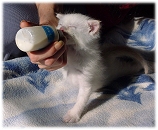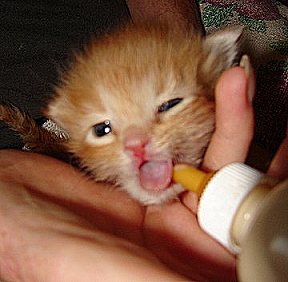| Bottle-feeding your Kitten | |||||
What You Need:
1. Prepare your supplies. Sterilize the kitten-sized baby bottles and nipples in a boiling water bath for about 5 minutes. Cool before using. Place a large towel, a rough-textured washcloth and a bowl of warm water on a table next to a comfortable chair.
2. Fill bottle with desired amount of commercial kitten milk replacement such as KMR and a pinch of plain yoghurt (for every feeding) which will help the kitty's digestion. There are several good milk replacers on the market, available in liquid or powder form. The ready-mix liquid is more convenient. Be sure the product is engineered for kittens and that it is fresh (some have a short shelf-life). Milk replacers can be found in any pet supplies store, most veterinary clinics, and even in some variety stores. DO NOT USE COW MILK! Never feed a kitten cow's milk or human baby formula as this causes stomach upset and severe diarrhea. If a kitten is already dehydreated, this could prove fatal. This includes condensed/evaporated canned cow's milk!
 Entirely Pets If the kitten seems weak, dehydrated or ill and you cannot get to a veterinarian right away, you should administer slightly warmed Pedialyte before offering the milk replacer. Warm the formula by placing the bottle in a bowl of very hot water, then test it against your forearm. It should be 95° to 100° fahrenheit, or approximately body temperature. Test the nipple to ensure the flow is just right. 3. Sit in the chair with the towel folded in your lap. Place the kitten prone (face down) on your lap. Make sure the kitten is warm before feeding. Feeding formula to a cold kitten can cause serious digestive problems. Without raising the kitten's head, place the kitten's head gently on your palm and guide the nipple into his mouth. He should start nursing right away. If all goes well, let him continue nursing until finished. Do not overfeed.
4. If the kitten does not start nursing right away, or if he seems to have trouble getting the milk, check the nipple again. It should not drip milk when held upside down, but should drip given a small amount of pressure. It may also be helpful to stroke his head or gently pet his back to start his nursing reflexes, but once he gets the idea, he will nurse readily. 5. Much like human babies, kittens may need "burping" after nursing. This is best accomplished by holding one hand under his abdomen and gently patting his upper back. Not too hard - you don't want him to vomit. If he doesn't burp right away, go to step #6. 6. The mother cat will stimulate her kitten's elimination by licking his anus and genital area with her rough tongue. You can emulate this process with a warm, damp, rough washcloth or dampened paper towel. It may take a couple of feedings to see results, so don't despair if he doesn't defecate right away. Urinating may take a bit longer. 7. Your kitten will want to sleep after nursing, so put him back into his bed to let him sleep undisturbed. 8. Your newborn kitten will need approximately 32 cc (1.1 oz.) of formula a day, divided into 9 - 12 feedings a day, depending on his size and condition. Count on feeding him every two hours or so, around the clock, for starters. Yes, it's a demanding job, but intensely rewarding to watch your newborn develop and grow.
 Entirely Pets Tips: 1. In a pinch, if you can't get kitten baby bottles, an eye dropper will do. Be very careful to drop only a very small amount on the kitten's tongue to avoid aspiration of the formula into his lungs. | |||||
|
 Petco | |||||
Oct 8, 2005
Bottle-feeding your Kitten
Subscribe to:
Comments (Atom)



